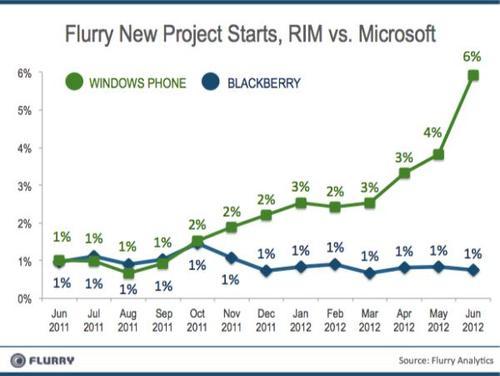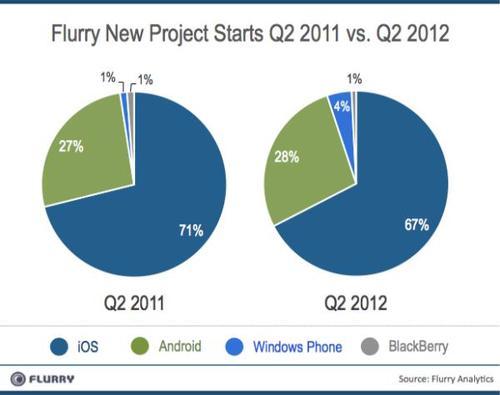This week, wedged between Apple’s WWDC and Google I/O is Microsoft’s Windows Phone Summit in San Francisco on Wednesday, June 20. Additionally, Microsoft is holding a last-minute press conference that “you don’t want to miss” tonight in Los Angeles. Barnes & Noble claims they are not part of the announcement, and others speculate that Xbox Live streaming will be part of the offering. Given the popularity of gaming on smartphones and tablets, and the strength of the Xbox platform, this would be a strong move for Microsoft. Because the development community is strongly made up of gaming studios, a move such as this could help galvanize the 3rd-party development community. Over the last couple of years, there has been an all-out war among Apple, Google, Microsoft, RIM and others to win the hearts and minds of developers. It appears that Microsoft is now making its move.
This report follows up on another released by Flurry earlier this month, showing that Apple continues to hold a strong lead over Google’s Android for developer support. Looking beyond the top two platforms supported by developers, Flurry evaluates the possibility for a 3rd legitimate platform provider to emerge at this stage of the game. At Flurry, we track developer support across the platforms that compete for their commitment. When companies create new projects in Flurry Analytics, they download platform-specific SDKs for their apps. Since resources are limited, choices developers make to support a specific platform signal confidence, as they invest their R&D budget where they expect the greatest return. Flurry Analytics has been adopted by more than 70,000 companies across more than 190,000 applications. Let’s start with a comparison of the Research in Motion (RIM) versus Microsoft.

The chart above shows the percent of new project starts represented by Microsoft and RIM among all platforms Flurry supports (e.g., iOS, Android, BlackBerry, Windows Phone, etc.). A new project start in the Flurry system is when a developer sets up an application for analytics tracking prior to the launch of that app. Over the past 12 months, Project starts for Windows Phone have grown by more than 600%, now accounting for 6% of all new project starts in the Flurry system during June 2012. As a percent of new project starts, RIM has remained flat. Overall, on an absolute basis, total new project starts within Flurry have grown by approximately 50%.
We next combine all new projects across the top 4 platforms within the Flurry system, comparing Q2 2011 versus Q2 2012.

The chart above compares the percent of new projects built by developers per platform within Flurry. For this snapshot, we compare Q2 2011 versus Q2 2012. Year-over-year, developer support has shifted, with Microsoft’s dent becoming more visible, now representing 4% during Q2 2012. iOS and Android share continue to oscillate mildly now clocking in 67% for iOS and 28% for Android. BlackBerry remains flat. What is important to note is that all four platforms are growing, just at different rates. Specifically, growth rates per platform for year-over-year growth are: iOS 66%, Android 82%, Windows Phone 521%, BlackBerry 13%. Viewing the relative growth rates show just how much Microsoft is gaining against the market.
Considering the first chart in this report, Microsoft growth has been accelerating within Q2. If we look at just Android and Microsoft in the month of June, for every Windows Phone new project started, 4 have been started for Android. Considering the much smaller Windows Phone installed based compared to Android, Microsoft is currently over-indexing. From Google’s point-of-view, this must elevate Microsoft from an “also-ran” to a potential competitive threat with the resources and know-how to kick-start momentum and mount a campaign to reel in the second place player.
Generally, Windows Phone could be gaining against the entire market as a result of developer frustration for Android fragmentation, concern for increasing competition on iOS and a lack of faith in BlackBerry. Whatever the reason, it’s clear that Microsoft still knows how to attract third party developer support. With its Nokia-partnership and high anticipation around today’s Microsoft Tablet announcement, Flurry expects Microsoft to make continued headway over the course of 2012.